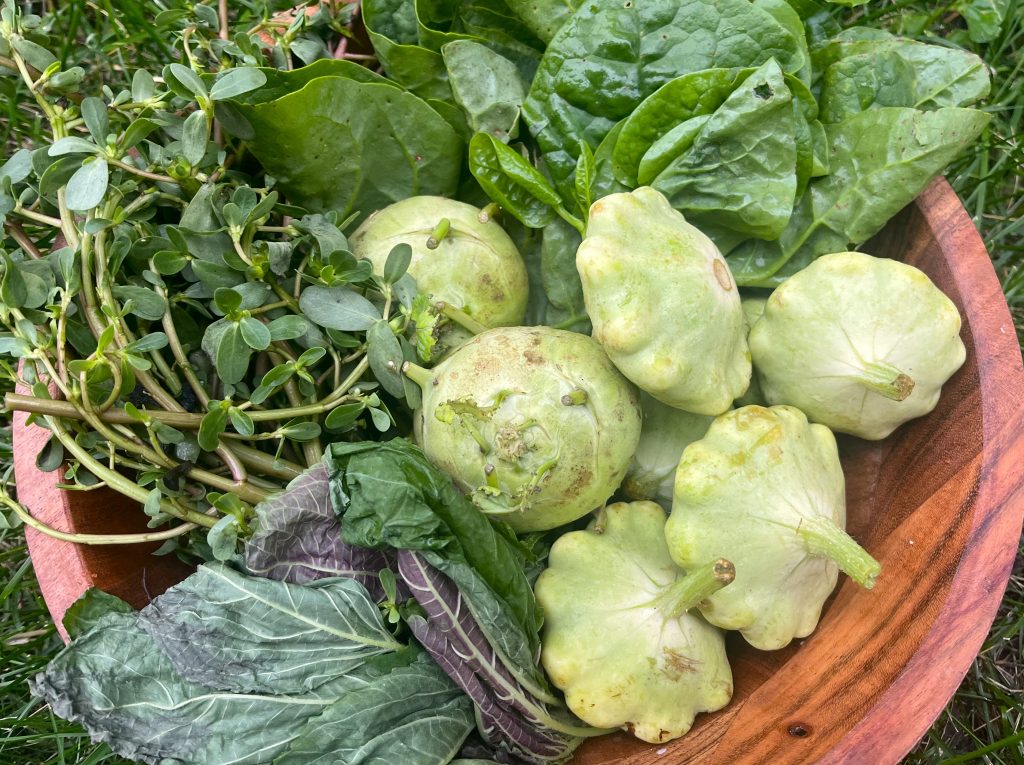Soua Chang
First installment of a new series explores how to use five lesser-known ingredients.

Clockwise from top: Malabar spinach, patty pan, kohlrabi, perilla leaves, purslane. Photo by Sophie Bolich.
Editor: This is the first installment of a new series in which Urban Milwaukee will explore five ingredients and how to use them with Milwaukee chefs, growers, and caterers.
It’s the height of summer and farmers markets are in full swing—vendor tables straining under pints of rotund blueberries, golden loaves of sourdough and wayward zucchinis swollen to twice the usual size.
If you’ve strolled through any Milwaukee-area markets, there’s a good chance you’ve encountered Soua Chang, whose family has been on the circuit for more than a decade.
They started at South Shore Farmers Market more than 10 years ago and still vend there today, but have since added locations including New Berlin, West Allis, Fox Point, Pewaukee, Walker Square Park and Enderis Park.
“I’ve been doing this since I was in middle school, helping my parents out,” he said. “It’s something they know how to do—something they grew up doing.”
Chang and his family, including his parents, brother and oldest sister, maintain a farm in New Berlin. Each year, they grow a wide variety of crops, from fresh herbs to fragrant flowers. Their offerings, geographically, span from East Asia to the Western Hemisphere.
Many of those make their way into Chang’s own kitchen, where his busy schedule and on-the-go lifestyle calls for fresh, simple meals. “I always do a mix of western and eastern cooking style, all depending on the mood,” he said.
So what’s in Chang’s refrigerator—and on his vendor table—that might surprise you? Here’s a closer look at five lesser-known ingredients he grows, and how to use them at home.
Purslane
“A lot of people are still learning about it,” Chang said of the succulent plant, which is both a superfood and a weed. It’s found in abundance at the family’s farm, but is also plentiful in sidewalk cracks across the city.
“I always tell people not to throw it away, but to eat it, you know, or play around with it,” Chang said.
Packed with omega-3 fatty acids, beta carotene and vitamin C, purslane is a fully fledged health food. But that’s just one thing to love.
“I use it almost like a microgreen,” said Chang, who likes to toss the tender leaves on top of salads, give them a quick sauté or mix them into soups and stews. “It has a sweet flavor with almost a citrus tang to it.”
Perilla Leaves
Also known as shiso, this aromatic leaf is a staple in Korean cuisine. The scalloped, palm-sized leaves are as flavorful as they are beautiful, often described as a mix between basil and mint with a whiff of anise.
“I actually do a lot with this,” Chang said. “You can dip it in tempura and deep fry it to make chips, or use it as a wrap or sandwich.”
He also recommends perilla as an accoutrement to Korean barbecue—perhaps its most famous application—and in pickled form as a refreshing side dish.
Patty Pan
Shaped like a UFO and just as mild as zucchini, patty pan is summer squash’s more glamorous cousin. The little saucers come in light green and buttercup yellow varieties, and go down just fine sautéed or grilled with a bit of garlic, Chang said.
His preferred method, however, is stuffing the squash like you would a mushroom. “I just scoop the top, stuff it and bake it,” he said, noting that patty pan’s buttery notes lend well to the richer preparation.
Kohlrabi
Cruciferous kohlrabi is closely related to cabbage, broccoli, and kale. Like its cousins, the crop can be bitter if it’s not prepared correctly, thanks to a high amount of sulfur-containing compounds called glucosinolates.
Mature plants can also be a bit woody, so seek out small to medium bulbs, Chang said. “It tastes like a combination between apple and cabbage,” he added, noting that the flavor shines in dishes like vinaigrette coleslaw—ideally, paired with red cabbage and carrots.
Though he tends to eat most vegetables raw, Chang sometimes adds kohlrabi to soups, skinning and chopping the bulbs before simmering them with spare ribs and broth.
Malabar Spinach
“It tastes just like spinach, but it’s actually more on the slimier side,” said Chang as he pulled a bunch of the red-stemmed leafy greens from a plastic bag.
But don’t let that put you off. The “slime” isn’t something to be grossed out by—it’s simply water-soluble fiber, similar to what you find in cooked okra and cactus pads.
It does prevent Chang from eating the plant raw. “It’s best cooked,” he said. “I don’t do too much to it, just a simple sauté with garlic, salt and pepper. It’s really good as-is.”
Malabar spinach, which thrives in warm temperatures, is also a great addition to soups, especially paired with chicken broth and lemongrass,” Chang added.
Purslane, perilla, patty pan, kohlrabi and Malabar spinach all have extended growing seasons, and will be available at markets until late into the season.
You can find the Changs’ booth, Chang & Xiong, at the following farmers markets: West Allis on Tuesdays, Thursdays, and Saturdays; Pewaukee on Wednesdays; South Shore on Saturdays; Walker Square on Sundays; Enderis Park on Sundays; and Fox Point on Saturdays.
If you think stories like this are important, become a member of Urban Milwaukee and help support real, independent journalism. Plus you get some cool added benefits.
Five Ingredients With a Foodie
-
Bartender James Potter
 Nov 21st, 2025 by Sophie Bolich
Nov 21st, 2025 by Sophie Bolich
-
Jenny Lee
 Sep 19th, 2025 by Sophie Bolich
Sep 19th, 2025 by Sophie Bolich
-
Ramses Alvarez
 Aug 27th, 2025 by Sophie Bolich
Aug 27th, 2025 by Sophie Bolich





















Thanks for this great new series!!
Love this
Great idea for a series! Enjoyed this one and am looking forward to the next installment!